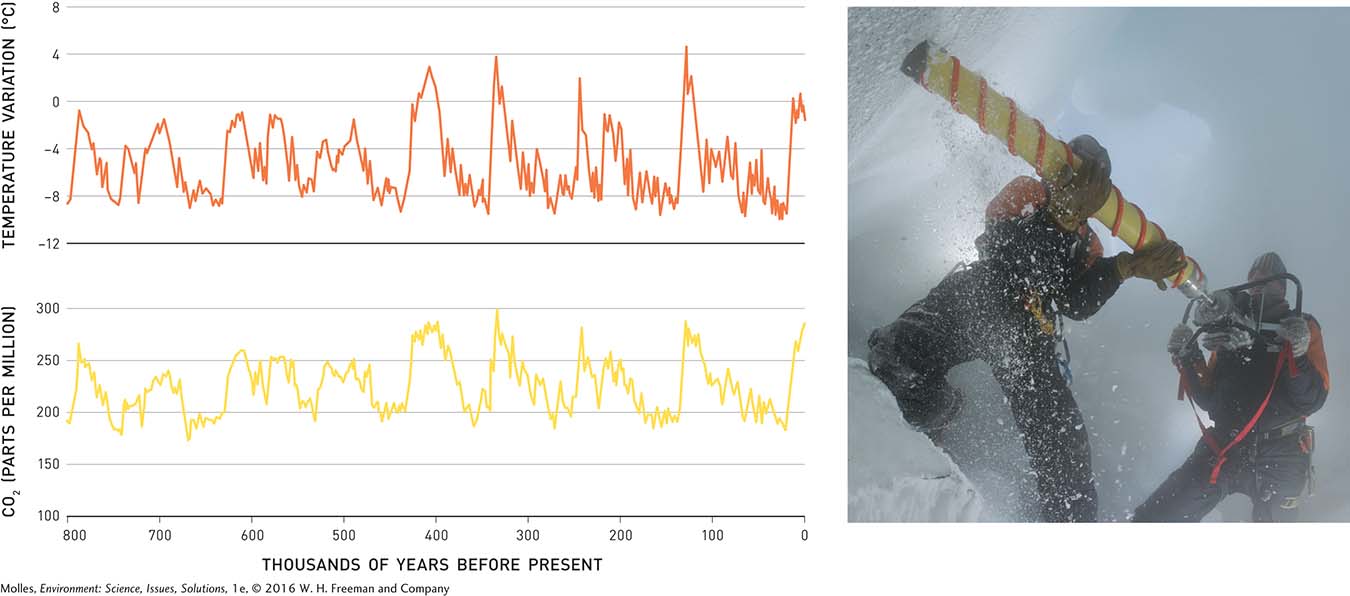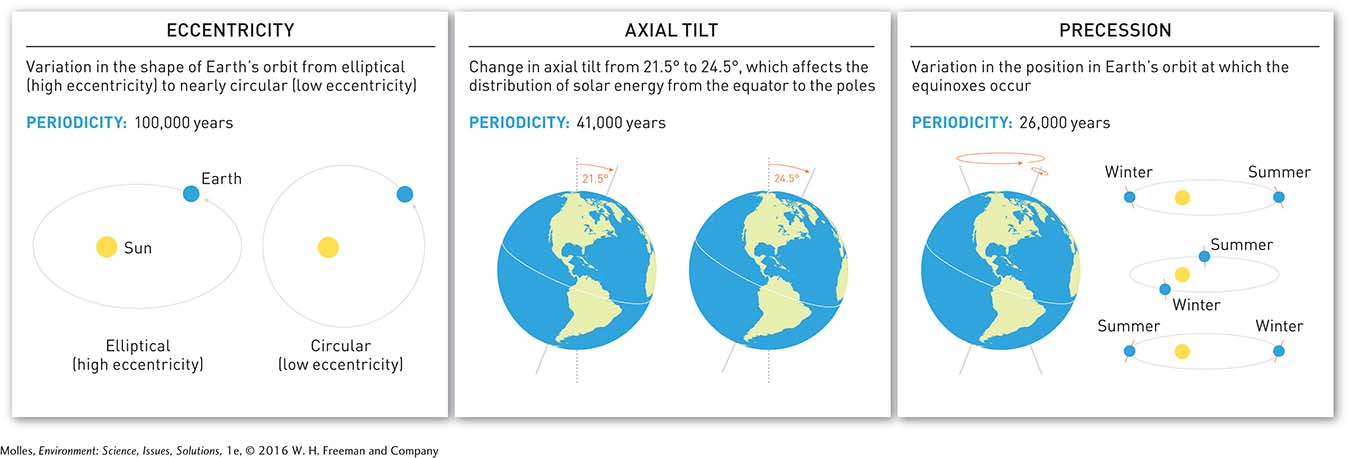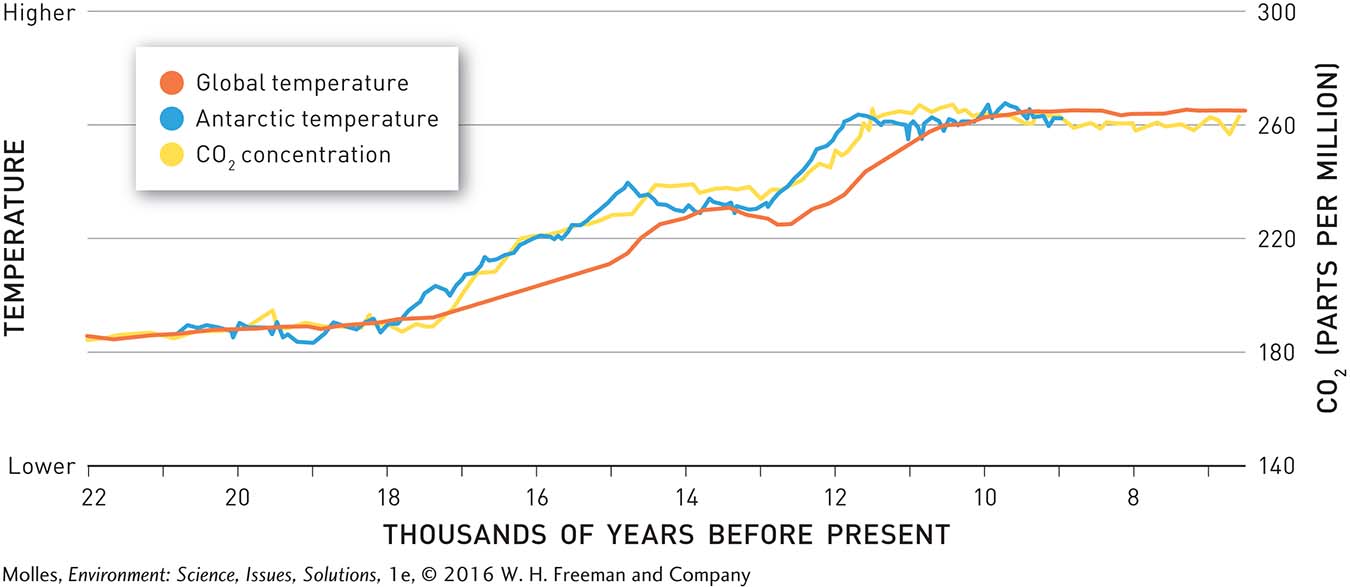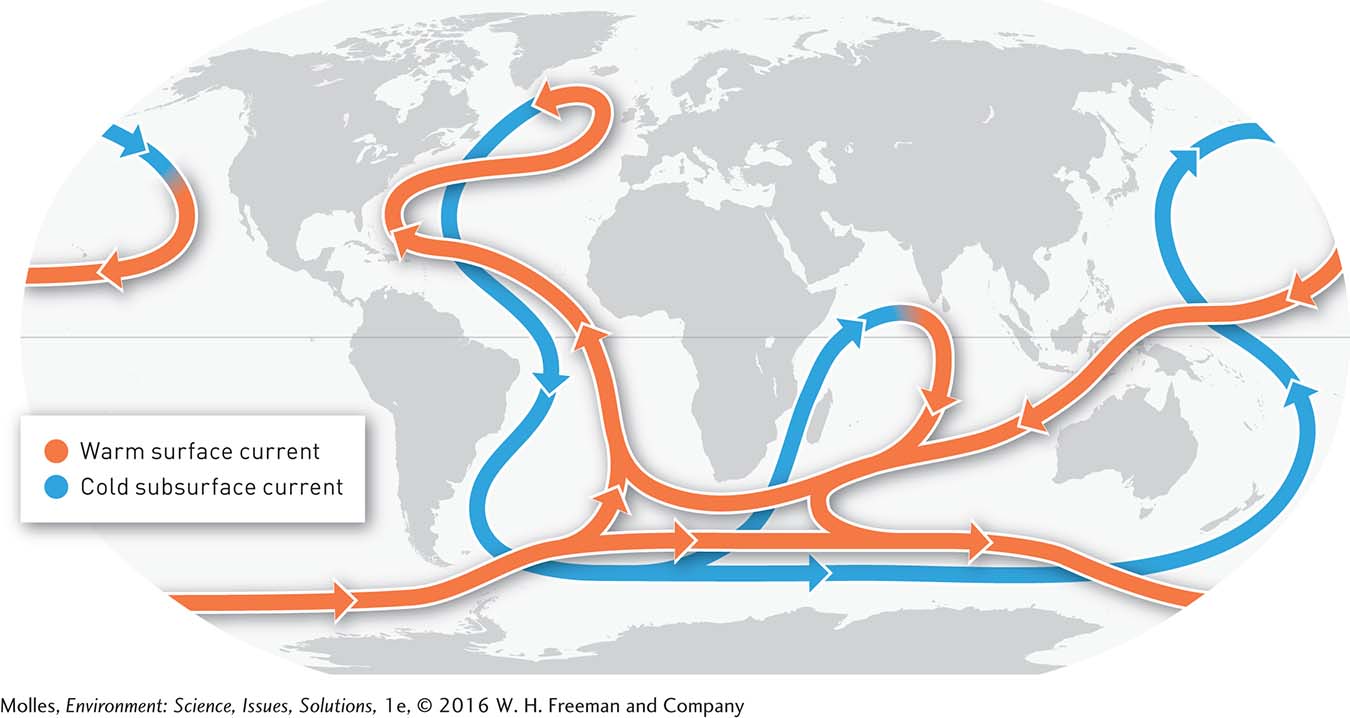14.3 Global temperatures and atmospheric CO2 concentrations have varied cyclically
Over the course of Earth’s history, there have been many ice ages, which have occurred with striking regularity. Although carbon dioxide concentrations in the atmosphere play a key role in the changing climate, scientists now understand that a number of factors interact to set the clock for these cycles.
The Climate Record in Ice
As snow accumulates in Earth’s cold places on high mountains and at high latitudes, it compresses lower layers and transforms snow into ice, trapping a sample of air from the distant past. It turns out that when temperatures are higher, water vapor in the atmosphere contains more deuterium, a heavy isotope of hydrogen. That means climate scientists can use these ice samples to measure both the past concentrations of gases in the atmosphere and to estimate historical temperatures.
European teams recently drilled more than 3.2 kilo-

Carbon dioxide has fluctuated over time. When temperatures were low, carbon dioxide levels were also low, and when temperatures were higher, carbon dioxide levels were elevated. One of the most notable features of the record of glacial and interglacial periods is their regular occurrence at approximately 100,000-
Role of Earth Orbital Cycles
In the 1920s and 1930s, Milutin Milankovitch, a Serbian astronomer, began studying the theory that ice ages were caused by periodic changes in Earth’s rotation on its axis and orbit around the Sun. He hypothesized that the amount of Sun hitting Earth during the summer is critical to the beginning or ending of an ice age because it dictates whether snow accumulates year after year. Milankovitch reasoned that when solar radiation was weak and temperatures cooler during Northern Hemisphere summers, snow would begin to accumulate, initiating an ice age.
eccentricity Variation in the shape of Earth’s orbit around the Sun.
Milankovitch identified three major aspects of Earth’s orbital cycles that could influence solar inputs. The first aspect is variation in the shape of Earth’s elliptical orbit around the Sun, which lengthens and shortens on a 100,000-
The second aspect is the cycle in the tilt of Earth’s axis of rotation, from a minimum of 21.5° to 24.5° every 41,000 years. The tilt cycle produces variation in heating of the planet’s two hemispheres at high latitudes. A low axial tilt decreases the amount of insolation at high latitudes, producing cooler summers, allowing snow and ice to build up, as well as warmer winters. During periods with a higher axial tilt, winter snow melts during the hotter summers at high latitudes. Currently, with an axial tilt of 23.5°, Earth is midway between these two extremes.
precession of the equinoxes Slow drift in the position in Earth’s orbit at which the quinoxes occur, a cycle repeating itself approximately every 26,000 years.
The third aspect identified by Milankovitch is that Earth wobbles on its axis on a 26,000-
Milankovitch Cycles Cyclic changes in the shape of Earth’s orbit, tilt in its axis, and precession of the equinoxes that produce variation in Earth’s climate.
These cycles are today referred to collectively as Milankovitch Cycles and seem to explain the occurrence of ice ages over the last 800,000 years (Figure 14.8). It’s important to understand how the Milankovitch Cycles affect Earth’s climate, but planetary motions do not explain the unprecedented rise in global temperatures over the last century.

Hemispherical Differences in Timing of Warming
Although CO2 and temperature are tightly coupled in the Antarctic ice record, scientists discovered that temperature increases there happen before carbon dioxide levels increase. That fact may seem puzzling, but as we shall now see, carbon dioxide is part of a global feedback loop, meaning it can be both a contributing cause and a consequence of a warming climate. In order to understand this concept, we need to zoom out of Antarctica and take a look at other forces that shape Earth’s climate as a whole.
Carbon dioxide clearly plays a key role in shaping Earth’s climate over geologic time. Scientists have begun to understand how it interacts with the Milankovitch Cycles and why we should be concerned about future carbon dioxide emissions. In 2012 Jeremy Shakun of Harvard and Columbia’s Lamont–
Rather than studying just an Antarctic ice core, he and his research team reconstructed temperature records from both the Northern and Southern Hemisphere using a variety of approaches. For instance, the tiny shells of some marine plankton contain both magnesium and calcium, but the ratios of these two elements are known to correlate closely with temperature. Rather than taking a core from the Antarctic ice, the researchers took cores from the ocean bottom, which contains these shells going back in time. On land, they could take cores from lake bottoms, which are packed with pollen from plants, which reflect the type of ecosystem present at a specific time. Examining these various cores, Shakun confirmed the Antarctic results that in the Southern Hemisphere warming occurred before CO2 increases. However, in the Northern Hemisphere, and on Earth as a whole, temperature began to rise five centuries after increases in CO2 (Figure 14.9).

Shakun proposed that Milankovitch Cycles had initiated the end of the last glacial period and set off a complicated reaction. First, greater sunlight in the Northern Hemisphere led to the melting of glaciers about 19,000 years ago. The influx of freshwater into the Atlantic Ocean weakened the Atlantic Meridional Overturning Current (AMOC), an ocean current that normally transports heat from the Southern Hemisphere to the north (Figure 14.10). This weakening trapped heat in the Southern Hemisphere, including Antarctica. As the southern oceans warmed, the solubility of the CO2 they held decreased, resulting in a release of CO2 to the atmosphere, much like CO2 is released from a carbonated beverage as it warms. This massive release of CO2 by the southern oceans amplified the warming of Earth via the greenhouse effect, speeding the end of the last ice age.

Thus, while the timing of ice ages and interglacial periods is set by Milankovitch Cycles, the speed of the transition may be determined by carbon dioxide in the atmosphere. As we shall see in the next section, when we think about Earth’s climate on a human timeline—
Think About It
Because higher carbon dioxide concentrations are correlated with higher temperatures in the 800,000-
year ice record, would it be accurate to conclude that carbon dioxide caused increases in Earth's temperature? Would a planet without Milankovitch Cycles have ice ages?
What other biological phenomena capture information on climates from the past?